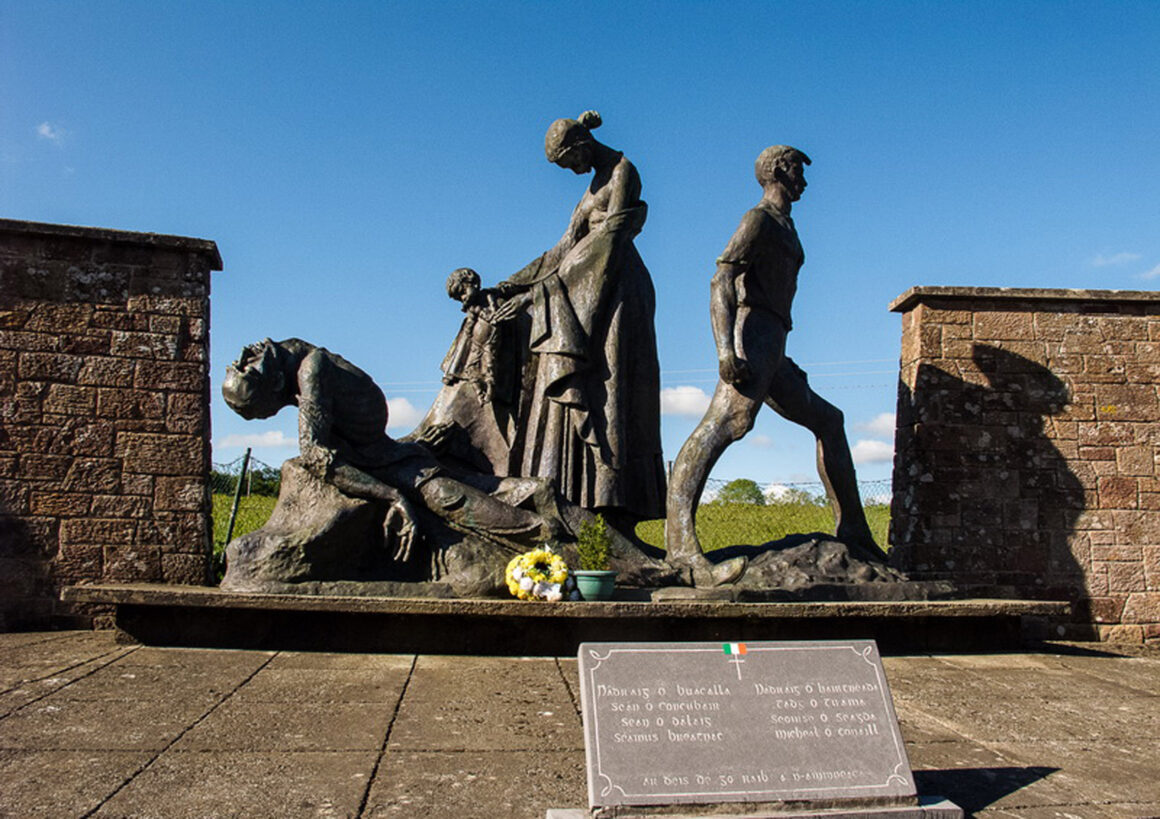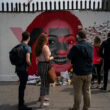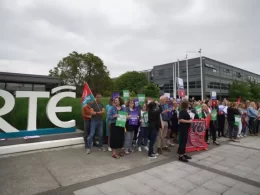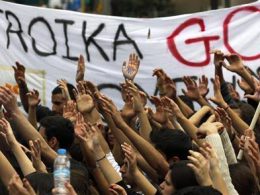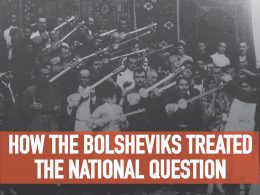This week marks 100 years since the outbreak of the Irish Civil War. The British prime minister threatened ‘terrible war’ unless the Anglo-Irish Treaty was signed. ‘Terrible war’ came anyway – only it was fought by men in green uniforms instead of British khaki. Manus Lenihan gives an account of this bleak final act of a period of revolutionary upheaval in Ireland.
One hundred years ago Tipperary town was the site of a conflict. But it was class war, not the struggle over the Treaty. 400 creamery workers had struck against a wage cut, occupied their workplace, raised the red flag and declared a ‘Soviet.’ They seized £42,000 from the bank, along with coal from a local aristocrat to fuel the town gas works – which were ‘sovietised’ under the red flag (1).
In August the pro-treaty National Army (NA) seized Tipperary after heavy fighting with anti-treaty forces. The NA, the new armed forces of the Irish Free State, put an end to the Soviet movement in the town, as they did all over the country as they advanced (2) The anti-treaty forces, the Irish Republican Army (IRA), burned down the creamery before they retreated, leaving the militant workforce unemployed.
This local episode in some ways represents the Civil War in miniature. On the part of the pro-treaty forces, we see repression in the interests of the wealthy. On the part of the anti-treaty forces, we see a stubborn resistance but a complete lack of strategy, leading to destructive actions. On the part of the organised workers’ movement we see great power and potential. But the labour movement was let down by its leadership over several years, then defeated during and after the Civil War by the violence of the pro-treaty forces.
Around 1,500 people lost their lives in the conflict, after the deaths of several thousand in the struggles of the years 1916-1921. For many, the Civil War is a particularly depressing and confusing episode. What was it all for? How could former comrades turn on each other? This article seeks to answer these questions from a socialist and working-class perspective.
The British government was not a neutral, honest broker in the Civil War. To begin with, we should make it clear that British imperialism bears direct responsibility for it.
How the British Empire triggered the Civil War
By 1921 the struggle for independence had reached a dead-end. There had been huge potential for a movement of the working class and poor in which socialism and national liberation were linked. This could have appealed to working-class and poor Protestants in the North. Instead Sinn Féin offered an independent capitalist Ireland which appealed to the Church and the wealthier classes. The leadership of the labour movement modestly stepped back and allowed them to take the lead, instead of boldly offering an alternative. Sinn Féin fought for this programme with a guerrilla strategy that, while heroic, had no chance of success in and of itself.(3)
This created the conditions for Civil War between those who were willing to sign the Anglo-Irish Treaty and those who believed the struggle was unfinished. There followed a tense period, with shootouts and hundreds of armed robberies. From April the anti-treaty leadership occupied the Four Courts in Dublin.
But over six months passed between the signing of the Treaty and the outbreak of war. War was not inevitable and the split was partly healed. Negotiations averted a battle in Limerick city. In May the two factions made a pact. In June they contested the general election under a common slate, and agreed in advance to form a joint cabinet. This was mere days before the outbreak of the Civil War.
But the British government viewed the pact as an ‘outrage’ and a ‘farce.’ Every time the Free State politicians tried to make peace, they were summoned to London like bold schoolchildren and lectured for days on end by Churchill, Lloyd George and co. The British politicians’ tone was ‘grave and even menacing’ when they discussed border clashes between the Free State and Northern Ireland. They had some nerve; forces armed by Westminster were carrying out a wave of sectarian violence across Northern Ireland. These crucial events, known as the ‘First Troubles,’ are dealt with more fully elsewhere. (4)
With the Four Courts occupation dragging on, Churchill insisted the Free State ‘must assert itself or perish and be replaced by some other form of control.’ (5) This was an implicit threat to re-invade Ireland. On other occasions he stood up in parliament and threatened war.
Churchill was not just concerned about the Four Courts, but about scenes of class struggle and land struggle in Ireland which he said reminded him of the French Revolution.(6) A more hard-line wing of the Free Staters agreed, warning that ‘red flag elements were taking advantage of the situation.’ (7)
For months, British troops had been gradually withdrawing from Ireland. But in response to the pact, the British army suspended the withdrawals and threatened war. There were in fact 5,000 British soldiers in barracks in Dublin right up to December 1922.
On 22 June – very soon after the election, with the pact still in force – two rogue IRA members shot dead General Henry Wilson on the streets of London. The British government claimed to have evidence that the gunmen were carrying out orders sent from the Four Courts. This was a useful lie. They ordered the 5,000 British soldiers in Dublin to seize the Four Courts using tanks, planes and artillery.
General MacReady judged that the politicians had lost the plot. He delayed implementing this order. In that time the Pro-Treaty forces finally gave in to the pressure from London and attacked the Four Courts themselves, shelling their own capital city with British guns. When a shell hit an ammunition store, a mushroom cloud rose over the Dublin quays.
There was certainly potential for civil war to break out anyway. But as we have seen, the British government had piled up combustible material for months, then lit a match and threatened to drop it. The Civil War was, like the guns which opened fire on the Four Courts, a parting gift from the Empire.
From street fighting to guerrilla struggle
The war unfolded in three stages. First there was a week of street fighting in Dublin. Anti-treaty forces took over various buildings in the city, and the Free State forces crushed them one by one. It appears the anti-treaty side hoped their comrades in other parts of the country would converge on Dublin and rescue them, but this was not a serious plan as they lacked the capacity to carry it out.
The second stage consisted of six weeks of conventional war in July and August. At first the anti-treaty side drove the NA out of areas such as the ‘Munster Republic.’ But the NA had armoured cars, artillery, machine-guns and a small air force, all supplied by the British state. They even carried out coastal landings. Without charts, threatening to shoot the civilian pilot, breaking the terms of the Anglo-Irish treaty, and using among other vessels the Helga (which had shelled Dublin in 1916), they landed 456 men and an 18-pound gun near Cork City. (8) In contrast to this boldness and initiative, the IRA were confused, passive and defensive. On 19 August, driven out of every city and town, the IRA leadership ordered a switch to guerrilla warfare.
The third stage was a guerrilla war lasting from August 1922 to May 1923. This phase claimed fewer lives than the previous two but cast a long shadow. The hardliners were now in charge of the Free State. President WT Cosgrave rejected all peace offers because his goal was to wipe out the anti-treaty forces. By May 1923 he had achieved his goal: there were fewer than 20 active-duty IRA members left in Dublin, along with scattered groups of 10-15 hiding out in the rocks along the western seaboard. The war ended not with a treaty or a peace process, but with an order to the remaining guerrillas to ‘dump arms.’
Terror
The Free State had spent the first six months of 1922 building up a new army. Former IRA elements were only a small component of the new NA; for the most part it consisted of First World War veterans and of jobless workers. Twelve shillings a week plus bed and board made a huge difference during the unemployment crisis of the time.
By late August the British government had supplied 27,000 rifles, hundreds of machine-guns and thousands of grenades. It’s fair to ask whether the Free State’s war effort would have had a leg to stand on without British support.
The early National Army was undisciplined, slovenly, mutinous and plagued with drink and venereal disease. It was delayed more by poor communications and transport than by enemy resistance.
The civilian leaders of the Free State were keen to wipe out the anti-treaty forces. But the military men were less bellicose. The rank-and-file would often fire over the heads of the ‘enemy.’ NA officers would carry on unauthorised negotiations. There was even a ‘Neutral IRA’ which claimed 20,000 members and called for a peace conference.
But many NA units gained a reputation for brutality and abuses, especially as the war dragged on. The Dublin Brigade under Paddy O’Daly carried out the most infamous massacres of the war, at Ballyseedy, Cahirciveen and Killarney in County Kerry. They tied up prisoners and detonated mines under them, eighteen prisoners in all. There were other less well-known atrocities. For example three officers, allegedly including O’Daly himself, abducted and tortured two young women in Kerry. Apparently this was a reprisal against their father, a local doctor, who had raised concerns about the conduct of NA soldiers. (9)
In Autumn 1922, the Free State began to carry out executions without trial. The Free State would claim that the executions were ‘inevitable if Ireland was to be saved from a descent into Bolshevism’ and that they ‘saved many lives and shortened the conflict.’ The security minister Kevin O’Higgins insisted that ‘there should be executions in every county.’ WT Cosgrave said that he would be willing to kill ten thousand people.(10) By the end of the war the Free Staters had executed 81 of their former comrades.
This campaign of state terrorism took other forms as well. An unknown number were abducted, tortured and murdered by the Criminal Investigations Department (CID). In October 1922, for example, they dumped the tortured bodies of three teenage boys in west Dublin. Twelve thousand were interned over the course of the war, and the press was banned from reporting on the brutality and squalor they often endured in the camps.
This reign of terror reached into the workplace: Christy Ferguson, an 18-year-old boilermaker at the Inchicore works, shouted ‘Up the Republic’ at work. He was taken to a barracks. There an officer beat him, saying, ‘I’ll give you up the ****ing Republic, you ****ing little Robert Emmett.’ The officer fired a pistol next to Ferguson’s head, then threw him into solitary confinement for days. (11)
Meanwhile the IRA was attempting to wage a guerrilla war without public support. It funded itself through armed robbery and declared that railway workers were military targets. There are plenty of documented examples of anti-Treaty IRA members committing atrocities. They helped the bosses to suppress many strikes, including with rifle-butts, warning shots and the threat of bayonets. (12)
Labour
At the start of this article we described workers’ power in Tipperary town. The Tipperary creamery was just one of 100 creameries occupied at the same time. (13) This gives a sense of the vast scale of the labour movement between 1918 and 1923. The footnotes below suggest further reading. Particularly good are Haugh, Kostick and O’Connor.
The year leading up to the Civil War was a window of relative peace, and a remarkable period during which the police, courts and army did not function. The liquidation of the colonial state led not to a Mad Max situation but to an upsurge of collective action by workers and poor farmers. 1922-1923 saw new heights in the centuries-long land struggle. Those who had been left behind by the partial reform won in the Land War now seized their chance to catch up. There were land seizures and burnings of landlord property.
These years were also a high point of involvement by women in political activism. This was reflected even during the tragedy of the Civil War. Three quarters of the IRA rejected the Treaty. But among Cumann na mBan (the women’s auxiliary to the IRA), the result was even more decisive: 12,000 members, or 86% of the membership, opposed the Treaty. They would go on to participate in the Civil War, to face internment and to take part in hunger strikes. According to prominent Free Staters these women were ‘not normal beings, with normal human mentality.’ They were scapegoated for starting the war. (14) With all this abuse, it’s no surprise that for decades after the Civil War, women were rarely seen in Irish politics.
By 1922 the Labour leadership had missed many opportunities to take the lead and inspire the struggle for independence with a socialist programme. When Thomas Johnson was asked about the creamery occupations, his response was typical: ‘Labour [is] unconnected with it and [has] no general policy of the kind.’ (15) Not long before, Johnson had been calling for an Irish Soviet Republic; now he couldn’t bring himself to support a Soviet creamery.
With such a complex situation and such poor leadership, the Labour rank-and-file were showing signs of confusion and exhaustion. But the workers’ movement still possessed tremendous strength.
There was a mood of resolute opposition to the Free State within the Labour movement but this is very hard to quantify. One indication, perhaps a confused and contradictory one, is the large minority which voted to abstain from the 1922 General Election at the February 18th Labour Party and Trades Union Congress.(16) In the election itself Labour showed massive potential when it ran for 18 seats, won 17, and missed the 18th by just 13 votes. (17)
An example of both strength and weakness is the April 1922 general strike ‘against militarism.’ This was the fourth general strike in five years. But in this case, the strength of the movement was applied to a point with zero leverage. It was a de facto demonstration in favour of the Free State. It was a strike ‘against militarism’ in name, but in nature it was a strike in support of the militarists.
The Labour leaders gave expression to the disgust felt by workers at the war. It was Labour which demanded a ceasefire to evacuate civilians when the Four Courts were being shelled (Arthur Griffith rejected the idea). It was Labour TDs who condemned executions and internment in the Dáil. By contrast, the Catholic Church hierarchy went all guns blazing in support of the Free State, and refused to condemn the executions.
The Soviets of Munster, as we have seen, were suppressed by the Free State. But 1922-3 saw a postal strike, a farm labourers’ strike in Waterford and a dock workers’ strike in Dublin. These were all major class battles. (18) The new postmaster-general JJ Walsh declared that Irish workers were lazy and would have to be ‘smashed’ as a ‘salutary lesson to the general indiscipline.’ (19) The great strikes of 1922-3 were indeed defeated with brute military force. The potential for a Workers’ Republic, or even for a strong trade union and labour movement in the new capitalist Ireland, was massively undermined. The ITGWU, the largest and most militant union, collapsed from 120,000 members in 1920 to 11,000 by 1931. Meanwhile, Labour’s vote collapsed in the 1923 General Election. (20)
Some socialists attempted to appeal to IRA members. Peadar O’Donnell, a member of the Communist Party of Ireland, was also on the anti-Treaty IRA executive. Liam O’Flaherty, later a famous writer, and Roddy Connolly, son of James, were two of over a hundred socialists who fought on the anti-treaty side during the battle for Dublin. Their courage should not blind us to the fact that their strategy was a disaster. The Revolutionary Socialist Party pursued a better policy, leading the Munster soviet movement. But both parties were very small and underdeveloped, and it appears both were dealt fatal blows by the Civil War and the repression that followed.
General Eoin O’Duffy, third-in-command of the Free State forces, feared socialism. In his opinion, any peace deal would only benefit ‘the Bolsheviks.’ ‘The Labour element and Red Flaggers are at the back of all moves towards “Peace” […] if the Government can break the back of this revolt, any attempts at revolt by labour in the future will be futile.’ (21) O’Duffy went on to a storied career: Garda commissioner, leader of the semi-fascist Blueshirts, founder of Fine Gael, and a soldier of Franco in the Spanish Civil War.
The fear of revolution
On the eve of the war the Free State cabinet complained that the anti-treaty side ‘were not prepared to wage war against Bolshevism sheltering under the name of Republicanism.’ Historian Peter Hart, quoting these words, clarifies that ‘Bolshevism’ simply meant ‘criminal violence.’ It is true that right-wingers used ‘Bolshevism’ as a political curse-word, but as the O’Duffy quote above shows, ‘Bolshevism’ did not simply mean ‘criminal violence.’
The Irish bourgeoisie labelled as ‘Bolshevism’ everything they hated, such as robberies and ‘gunmen,’ but much else besides, including strikes, the sharing of land and the participation of women in politics. It also had a more specific meaning: working-class culture in Ireland in this period was sympathetic to the Russian Revolution, as seen in the proliferation of ‘Soviets’ and the growing appetite for socialist ideas. Popular trade union papers of the time such as the Voice of Labour and Watchword of Labour certainly did not use ‘Bolshevik’ as a swear word but as a badge of honour.
The winning side in the Civil War consisted of those who wished to put an end to all this ‘Bolshevism,’ in every sense. The losing side consisted of a wide range of forces which, on behalf of a variety of causes, resisted.
The Free Staters saw themselves as the ‘rational,’ ‘scientific,’ ‘prudent’ side in the conflict. But the regime they set up was one of poverty, underdevelopment and religious extremism. For example, Labour TDs attempted to insert a clause in the new constitution recognising the equality of men and women, but this was rejected by the Free Staters, particularly Kevin O’Higgins.
Over 400,000 people emigrated in the 1920s, including many who had taken part in the revolution. The anti-treaty side came from a political tradition which, from Cú Chulainn to Pádraig Pearse, celebrated heroic failure. Thus many politicians, even those who lost the war, were able to dine out on the memory of the Civil War for a century afterwards. But a lifetime of silence and shame followed for many rank-and-file veterans of labour, national or women’s struggles.
Ferriter notes that in 1931 4,830 tenements in Dublin housed 25,320 families. In such conditions, the Irish Times commented, ‘It is almost a miracle that communism has not flourished.’ In fact, revolutionary socialism did ‘flourish’ in 1917-1923. The Civil War and its aftermath were the final stage in the defeat of this movement, and from the point of view of those living in the slums that was surely a tragedy and not a miracle.
- Emmet O’Connor, Reds and the Green, UCD Press, 2004, Chapter 3, ‘Civil War Communism’
- Emmet O’Connor, A Labour History of Ireland 1824-1960, Gill & Macmillan, 1992, p 113
- For more on this, see Kevin McLoughlin, ‘The War of Independence, the Working Class and the Struggle for Socialism,’ in Ireland’s Lost Revolution, 2016.
- See Ciaran Mulholland in Ireland’s Lost Revolution 1916-1923, Kevin Henry, ‘100 years since the Belfast pogroms: A warning from history,’ socialistparty.ie, July 17 2020
- Diarmuid Ferriter, Between Two Hells: The Irish Civil War, Profile Books, 2021, p 2
- Townsend, p 404
- Ibid p 39
- Cottrell, Peter, The Irish Civil War 1922-23, Osprey, 2008. P 62
- Ferriter, p. 105
- Ferriter p 94-95
- Ferriter, p 53
- For example, see Ferriter p 53, 94, 105
- Conor Kostick, Revolution in Ireland: Popular Militancy 1913-1923, Cork University Press, 1996 (2009), p 202
- Ferriter, p 79
- Kostick, p 204
- O’Connor, Reds and the Green, p 60
- Kostick, p 193
- For a detailed account, see Kostick p 204-213
- Ferriter, p 73
- Dominic Haugh, ‘More than a taste of power,’ in Let Us Rise: The Dublin Lockout – its impact and legacy, Socialist Party, 2013, 96
- Townsend, p 432





